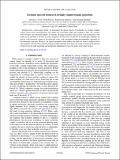Files in this item
Excitonic spectral features in strongly coupled organic polaritons
Item metadata
| dc.contributor.author | Cwik, Justyna Agnieszka | |
| dc.contributor.author | Kirton, Peter George | |
| dc.contributor.author | de Liberato, Simone | |
| dc.contributor.author | Keeling, Jonathan Mark James | |
| dc.date.accessioned | 2016-03-22T16:00:03Z | |
| dc.date.available | 2016-03-22T16:00:03Z | |
| dc.date.issued | 2016-03-22 | |
| dc.identifier | 241576377 | |
| dc.identifier | 5687f01a-eb82-4d5e-8568-b6a3b9356623 | |
| dc.identifier | 84962835289 | |
| dc.identifier | 000372485500012 | |
| dc.identifier.citation | Cwik , J A , Kirton , P G , de Liberato , S & Keeling , J M J 2016 , ' Excitonic spectral features in strongly coupled organic polaritons ' , Physical Review. A, Atomic, molecular, and optical physics , vol. 93 , no. 3 , 033840 . https://doi.org/10.1103/PhysRevA.93.033840 | en |
| dc.identifier.issn | 1050-2947 | |
| dc.identifier.other | ORCID: /0000-0002-4283-552X/work/27559414 | |
| dc.identifier.uri | https://hdl.handle.net/10023/8461 | |
| dc.description.abstract | Starting from a microscopic model, we investigate the optical spectra of molecules in strongly coupled organic microcavities examining how they might self-consistently adapt their coupling to light. We consider both rotational and vibrational degrees of freedom, focusing on features which can be seen in the peak in the center of the spectrum at the bare excitonic frequency. In both cases we find that the matter-light coupling can lead to a self-consistent change of the molecular states, with consequent temperature-dependent signatures in the absorption spectrum. However, for typical parameters, these effects are much too weak to explain recent measurements. We show that another mechanism which naturally arises from our model of vibrationally dressed polaritons has the right magnitude and temperature dependence to be at the origin of the observed data. | |
| dc.format.extent | 12 | |
| dc.format.extent | 672999 | |
| dc.language.iso | eng | |
| dc.relation.ispartof | Physical Review. A, Atomic, molecular, and optical physics | en |
| dc.subject | QB Astronomy | en |
| dc.subject | QC Physics | en |
| dc.subject | DAS | en |
| dc.subject.lcc | QB | en |
| dc.subject.lcc | QC | en |
| dc.title | Excitonic spectral features in strongly coupled organic polaritons | en |
| dc.type | Journal article | en |
| dc.contributor.sponsor | EPSRC | en |
| dc.contributor.sponsor | EPSRC | en |
| dc.contributor.sponsor | The Leverhulme Trust | en |
| dc.contributor.sponsor | EPSRC | en |
| dc.contributor.institution | University of St Andrews. School of Physics and Astronomy | en |
| dc.contributor.institution | University of St Andrews. Condensed Matter Physics | en |
| dc.identifier.doi | 10.1103/PhysRevA.93.033840 | |
| dc.description.status | Peer reviewed | en |
| dc.identifier.grantnumber | EP/M010910/1 | en |
| dc.identifier.grantnumber | EP/I031014/1 | en |
| dc.identifier.grantnumber | IAF-2014-025 | en |
| dc.identifier.grantnumber | EP/M025330/1 | en |
This item appears in the following Collection(s)
Items in the St Andrews Research Repository are protected by copyright, with all rights reserved, unless otherwise indicated.

